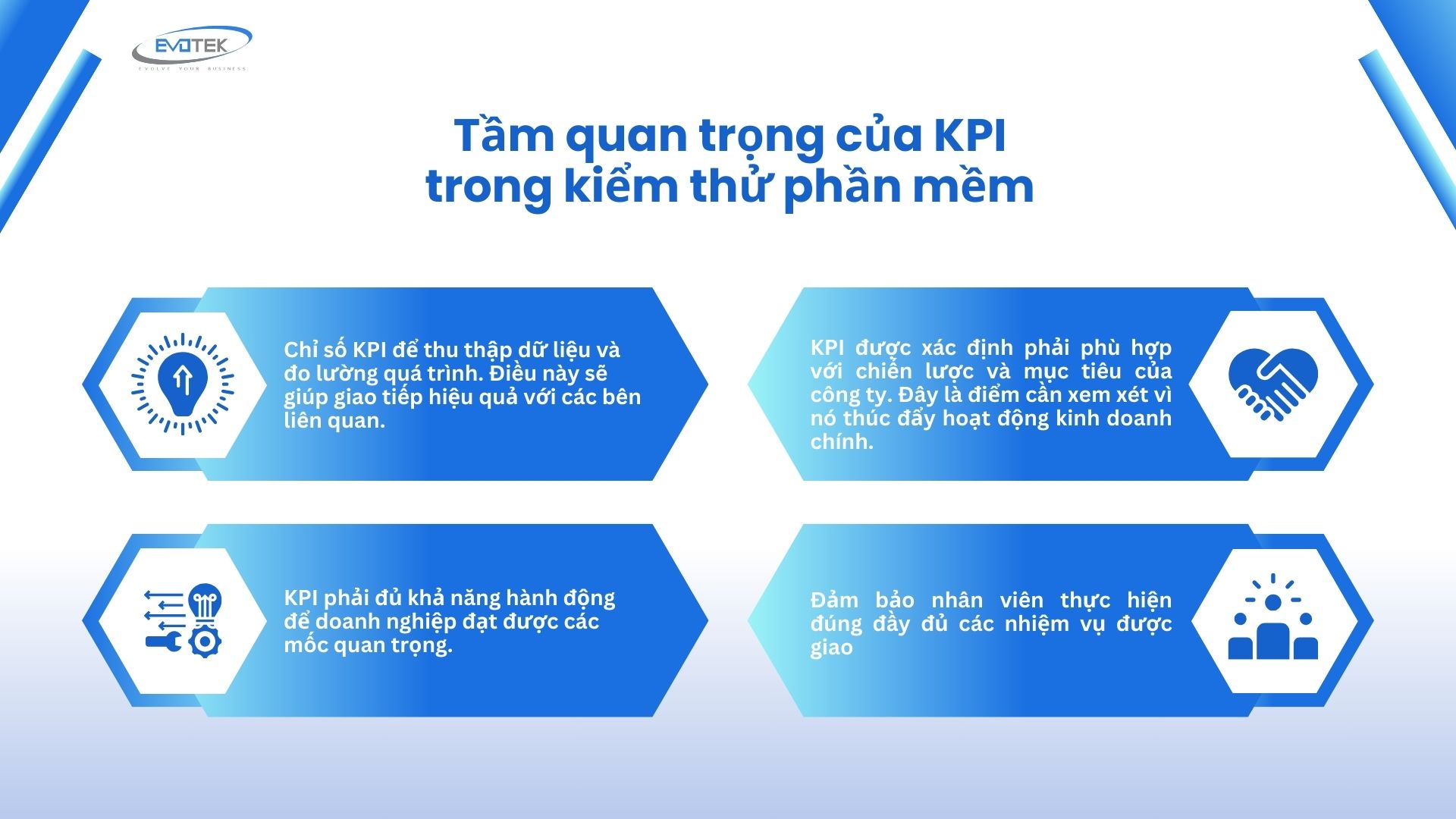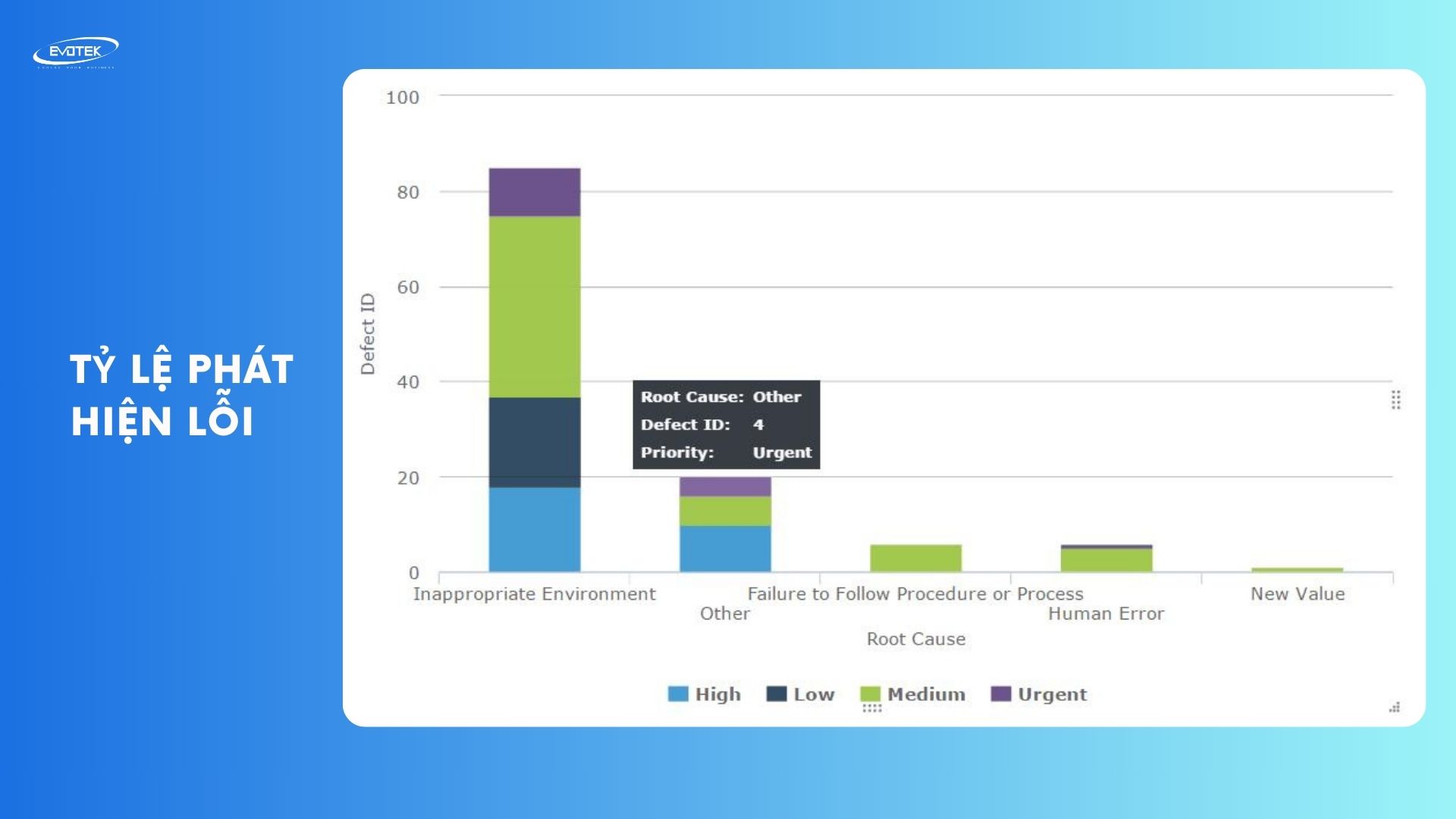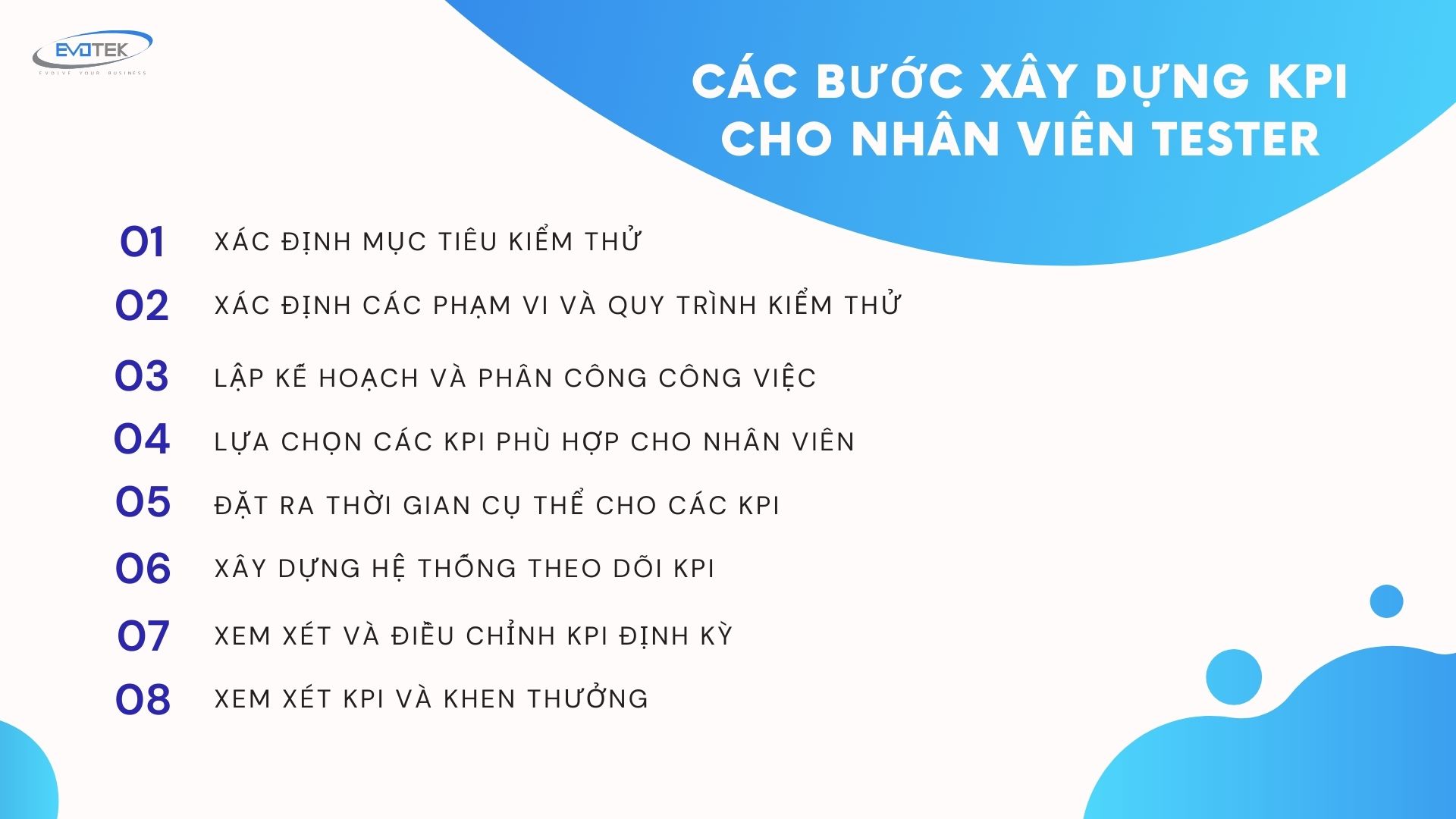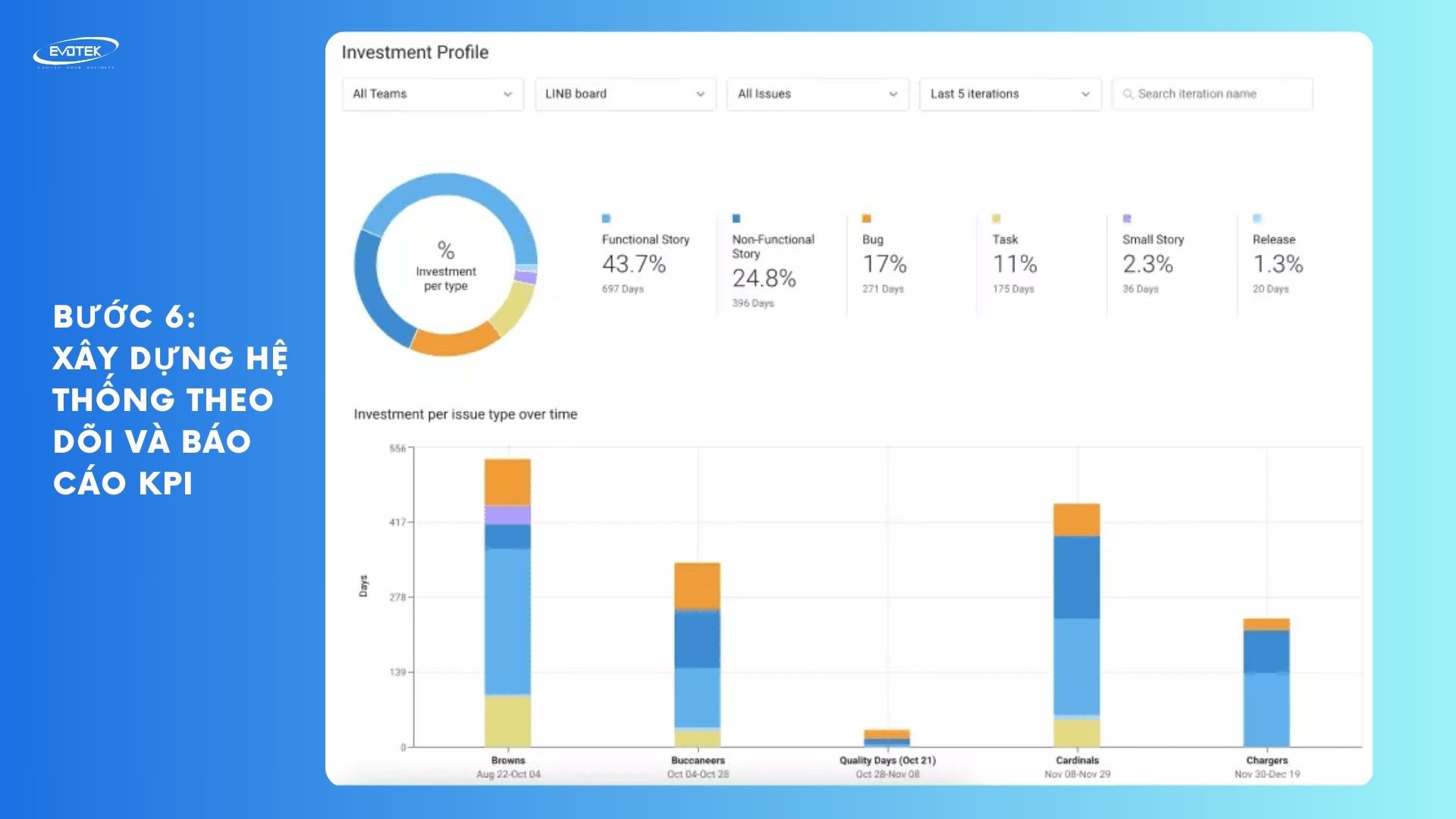In the realm of software development, ensuring software quality holds greater significance than ever before. According to IBM, rectifying a bug discovered post-release costs six times more than rectifying one identified during testing. A real-life example of Samsung recalling repairs for the Samsung Note 7 phone line due to an explosion problem. Fixing this error cost Samsung nearly 17 billion USD.
Consequently, by 2023, 45% of businesses have earmarked budget allocations for software testing to preempt errors, curtail costs, and enhance customer satisfaction. However, to optimize performance, it is imperative to establish appropriate goals and key performance indicators (KPIs) for testing personnel.
KPIs serve as crucial benchmarks that guide and assess employee performance, ensuring alignment with the business’s objectives and directing the software testing process effectively.
Below, Evotek outlines 8 steps to formulate effective KPIs for testers, QA personnel, and test and QA team managers to reference when establishing tailored KPIs for team members.
The Significance of KPIs in Software Testing
KPIs play a pivotal role in evaluating performance and gauging the quality of work within the QA team. By furnishing specific metrics, they enable management to systematically monitor, evaluate, and enhance the QA process.

Setting Key Performance Indicators (KPIs) in software testing holds significant importance for several reasons:
- KPI indicators for data collection and process measurement. This will help in effective communication with stakeholders.
Example 1: Defect Leakage Rate – This metric tracks the number of defects identified during testing that are encountered by customers. It allows the testing team to assess the efficacy of their testing process and pinpoint areas for improvement.
Example 2: Test Coverage – This KPI measures the proportion of code or requirements covered by the test suite. Monitoring test coverage ensures that testing efforts comprehensively address all crucial aspects of the software.
- Identified KPIs must be consistent with the company’s strategy and goals. This is a point to consider as it drives the core business.
Example 1: Defect Detection Efficiency – If the company aims to enhance software product quality, a KPI like defect detection efficiency (percentage of defects identified during testing compared to the total number of bugs in the product) can guide testers in working towards this objective.
Example 2: Requirements Coverage – For companies prioritizing delivering software that fully meets customer needs, a KPI measuring the percentage of requirements validated by available test cases ensures testing activities focus on verifying critical requirements fulfillment.
- Key Performance Indicators (KPIs) must offer actionable insights for businesses to reach significant milestones.
Example 1: Automation Test Coverage – By monitoring the percentage of automated test cases, the QA team can pinpoint areas of manual testing that could be streamlined, freeing up resources for other testing tasks.
Example 2: Cost of Missed Defects – This KPI assesses the financial impact of unresolved defects discovered by customers post-testing. By tracking this metric, the QA team can identify major costly defects and address them promptly.
- Ensuring Employees’ Adequate Task Performance: Evaluation metrics aid in gauging work efficiency, providing clear, transparent, and equitable assessments of testing staff’s results and performance.
Important KPIs for the QA Team:
Here are some important KPIs that testing team managers should consider:
Error Detection Rate
The Error Detection Rate serves as a vital KPI for evaluating testing process efficacy. It indicates the proportion of defects identified during testing relative to the total defects in the product. This KPI assesses testers’ error identification abilities and the effectiveness of testing methodologies employed.
Calculation Formula: (Number of errors detected during testing phase / Total number of errors in the product) x 100%

Error Detection Speed
Error detection speed refers to the rate at which errors are identified within a specific timeframe, typically on a weekly or monthly basis. This metric helps assess the efficiency and promptness of the testing process, allowing for adjustments to resources and methodologies as needed.
Calculation Formula: Number of detected errors / Number of days (or weeks, months) tested
Average Error Recovery Time
The average error recovery time measures the typical duration required to resolve a bug from the moment it is discovered. Reducing this timeframe contributes to shortening the development cycle, thereby enhancing project efficiency and productivity.
Calculation Formula: Total time taken to fix errors / Total number of errors fixed
Serious Error Detection Rate
This KPI focuses on critical errors that significantly impact the product’s functionality and user experience. By monitoring the rate of critical defect detection, testers can prioritize and address the most crucial issues, thereby ensuring overall product quality.
Calculation Formula: (Number of high/serious errors / Total number of detected errors) x 100%
Testing Coverage Rate
The testing coverage rate, or test coverage ratio, gauges the percentage of source code or features that have undergone testing. This metric aids in assessing the thoroughness and efficacy of testing efforts, highlighting areas for enhancement.
Calculation Formula: (Number of code lines/features tested / Total number of code lines/features) x 100%
Steps to Develop KPIs for Testers
When crafting KPIs for tester employees, it’s crucial for managers to adhere to the SMART criteria
- S (Specific): Ensure KPIs are specific and clearly defined.
- M (Measurable): KPIs should be quantifiable and measurable.
- A (Achievable): Set KPIs that are realistically attainable.
- R (Realistic): KPIs should align with the reality of the testing environment and resources.
- T (Time-bound): Establish specific deadlines or timeframes for achieving KPIs.

Step 1: Establish Testing Goals
Managers outline overarching KPIs aligned with business objectives, detailing specific tasks and responsibilities for employees to ensure product quality, error detection and prevention, and compliance with quality standards. For instance:
What are the Tester’s duties and expected outcomes?
What resources will be provided for Tester to fulfill these responsibilities?
Timely completion of tasks and meeting deadlines merits recognition for the Tester.
Step 2: Define Testing Scope and Procedures
Managers clearly delineate the scope of testing and the corresponding processes to be followed. This may include:
- Functional testing
- Integration testing
- Interface testing
- Security testing
Step 3: Planning and Task Assignment
Develop a comprehensive plan for testing activities, outlining tasks, timelines, and assigning specific responsibilities to each tester.
Step 4: Selecting Appropriate KPIs for Employees
In alignment with testing objectives, plans, and procedures, managers will identify suitable KPIs to evaluate tester performance. Some relevant KPIs include:
- Number of completed test cases
- Number of errors detected
- Error detection rate (calculation: number of detected errors/total number of errors)
- Error detection speed (calculation: number of errors/testing time)
- Test coverage (calculation: percentage of source code/function tested)
- Average time to detect and report errors
- Number of test cases executed automatically
- Number of test cases executed successfully or unsuccessfully
Step 5: Establishing Timelines for KPIs
Managers should define clear and measurable timelines for each KPI, drawing from historical data, industry standards, and organizational objectives to assess the performance of Tester employees.
Setting specific timelines enables testing and quality assurance personnel to prioritize tasks effectively and adapt their work approach to align with project progress.
Timelines for KPIs may encompass short-term and long-term milestones, delineated by daily, weekly, and monthly intervals.
For instance, a KPI targeting defect detection rate during testing could aim for a short-term goal of a 10% increase within a three-month period.
Step 6: Implementing a KPI Tracking and Reporting System
To ensure effective tracking and evaluation of KPIs, managers should implement a dedicated tracking and reporting system. This system facilitates the collection, analysis, and presentation of data pertaining to KPIs, offering a comprehensive overview of the performance of software testing staff.

In software testing, various effective work management tools aid in organizing, tracking, and coordinating testing activities. Some popular tools include:
- Jira: Facilitates task management, tracking, recording, and management of discovered errors during testing.
- qTest: Serves as a test and requirements management tool, allowing for the creation and storage of test cases, tracking test progress, and generating reports.
- Trello: Enables the management, assignment, and tracking of testing tasks within projects.
Step 7: Periodic Review and Adjustment of KPIs
Regularly reviewing and adjusting KPIs is essential to ensure their alignment with changes in business goals, processes, and technology, thereby maintaining their relevance and effectiveness.
This practice ensures that KPIs accurately measure the performance of testing and quality assurance staff.
If certain KPIs are found to be outdated or no longer suitable, managers should review and modify them accordingly. Additionally, new KPIs may be introduced to reflect the organization’s evolving priorities and objectives.
Step 8: Review of KPIs and Implementation of Rewards
Managers should incorporate KPIs into a performance evaluation and reward system for testers, motivating them to continually enhance their performance. This approach fosters a culture of continuous improvement and incentivizes testers to strive for excellence in their work.
In Conclusion
Establishing effective KPIs for the QA team is crucial to ensure software quality and streamline the testing process. By identifying appropriate KPIs, setting clear objectives, and implementing best practices, companies can enhance transparency, accountability, and performance within their quality testing teams. This fosters continuous improvement in product quality, mitigates risks, and boosts customer satisfaction.
Quality Testing with Evotek
At Evotek, we recognize the significance of establishing relevant KPIs for our testing and quality assurance personnel. Leveraging years of experience in software testing, we have developed a robust process for setting professional KPIs, ensuring alignment with company objectives and meticulous measurement. Our commitment to upholding established KPIs guarantees the proficiency of our testing staff.
Evotek is a leading provider of comprehensive and effective quality assurance solutions, staffed by a team of seasoned and dedicated experts. With a team of experienced and dedicated experts, Evotek is committed to providing software testing services of the highest standards on the market.
Evotek uses the most advanced testing methods and tools, combined with a professional and optimal workflow. The company always ensures high transparency and accountability in every project, bringing maximum satisfaction to customers.
Guided by the principle that “Quality is paramount,” Evotek continuously pioneers advancements in software testing, delivering flawless products and services to clients worldwide.

 日本語
日本語 한국어
한국어 Tiếng Việt
Tiếng Việt 简体中文
简体中文